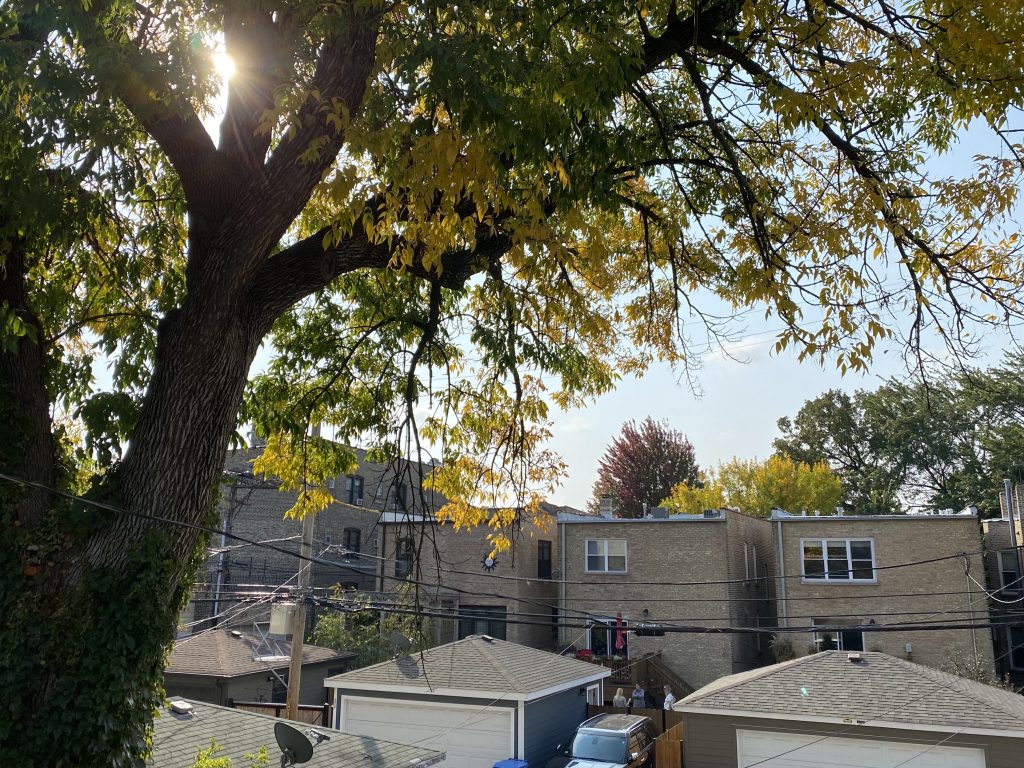
The tree in my backyard is dying. It’s big and beautiful – more than three stories tall – and because it is so big, it’s an ecosystem to itself, with two types of vines growing up the side, and two or three squirrels nests and I think a pair of cardinals who come back to roost every spring. But it’s an ash tree, and for the last four years we’ve noticed the telltale half moon Emerald Ash Borer holes in the bark, knowing that it was only a matter of time before this gorgeous beauty would have to come down.
I don’t want to let the tree go. It was the first thing I noticed when I saw our house thirteen years ago, and it has been such a wonderful constant, shading my yard, giving me squirrel families to watch, that I just can’t imagine life without it.
The tree has gone on much longer than any of us thought possible. Only this year did it really begin to show signs of crown die-back, where the top branches are denuded and the tree desperately sprouts new branches lower down in an effort to keep living. The Ash Borers eat away at the layer just under the bark, where sap travels up to the top, gradually starving leaves at the top of nutrients, killing the tree from the sky-side down.
At least eight feet in diameter at the bottom, it straddles the property line with my neighbor to the east. The neighbor house is a borderline slum house, owned and managed by an absentee restaurant owner who doesn’t care who lives in the house or to spend any money to maintain it. It has rat warrens in the backyard, and for a time I’m pretty sure the house hosted a meth lab. Although the police said they couldn’t confirm it, the people going in with propane tanks and out with black duffel bags everyday was a pretty big tip off.
The tree has seen all this. I’m guessing it’s about 90 years years old, planted in the 1930’s, when it appears someone tried to landscape the backyard with white flagstones and a thin concrete sidewalk to the alley. The concrete was well worn and broken by the time we moved in, and the flagstones we discovered years later, since dirt and grass had grown over them, creating an inch-thick layer we only discovered when idly digging in the dirt.
What has this tree seen? The back alley used to be mud. The backyards used to go to the alleys, unfettered by garages and cars. My neighbor’s cheap vinyl shingles cover up wood. There didn’t used to be planes flying overhead to O’Hare. Nearby Western Avenue once had a streetcar clattering along.
Were there happy families in those backyards under the tree? Did they admire the tree like we do?
There’s a three-foot stretch along one side of the tree uncovered by vines. The squirrels use it as a sort of road when they scamper up and down, their claws scratching the bark. Was it worn by generations of squirrels living in the tree?
The last four years have been a kind of ash tree death watch. Other ashes along our street were quickly consumed by ash borers. Turned into bare, dead carcasses, then chopped down with stumps ground into saw dust. Disappeared from our world.
We’ve half-heartedly researched what to do when the tree comes to an end. We know tree trimmers, but is there anyone who wants to save all this old growth wood? Could someone make furniture? Baseball bats?
The tree hangs over power and cable lines, so we can’t let it go too long. But our neighbor, who speaks Thai and apparently no English, will likely be a challenge when it comes time to divvy up the responsibility and cost for taking down the tree. For years I have dreaded that difficult conversation.
Every spring, we peer up to see how many leaves have come out, and each year we’re cautiously happy to see our tree alive for another year. To shade our backyard and give us a chattering squirrel and bird ecosystem.
But it will come to an end. Maybe next spring, maybe the one after that. Soon.
And after that, I’m not sure what we’ll do to fill the space this big tree filled in our lives.